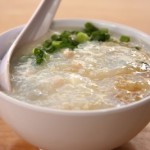 We’ve all been sick at one time or another.
We’ve all been sick at one time or another.
Maybe you’ve been cozied up to the toilet all night with the stomach flu, maybe you’ve eaten something that doesn’t agree with you, or maybe you’re in bed with a whopper of a cold.
Whether it’s the flu, food poisoning, or the cold from hell, sooner or later you’ll begin to recover.
You begin to feel a little better and want to eat something, but what?
Should you go for that leftover pizza in the refrigerator? Maybe a scrambled egg? It’s hard to tell what’s going to sit well and not make you feel worse.
What to Eat When Sick…
My solution is to make a simple congee.
A congee is the Chinese equivalent to chicken soup when you’re feeling funky. Also known as jook, a congee is a kind of thick rice soup or porridge with a creamy consistency.
It’s easy on the stomach and a good place to start when you’re recovering from an illness.
Because it’s made from rice, a congee is a great choice because it’s easy to digest, and is gluten-free, so it’s unlikely to cause food allergies.
A congee is mild enough that a baby can eat it.
What’s more, it has anti-diarrhea and anti-vomiting properties.
Congees are a common meal in many Asian countries. They can be sweetened and eaten for breakfast or cooked with broth, vegetables, and a protein for an evening meal.
Congees are served everywhere from rural China to the Wynn Hotel in Las Vegas.
Here’s my basic recipe:
Combine one part rice with 8 parts water (for a thinner congee, add two more cups of water) and simmer over a very low heat until the rice is tender.
For a complete meal, you can add broth and a protein (chicken, shrimp, pork, tofu, or egg), vegetables, sesame oil and herbs to suit your taste and health needs.
You can use either white or brown rice in your congee. If you use white, try long grain jasmine rice for flavor. If you use brown rice, go for a medium grain and cook it a little longer. Also, a congee made with brown rice will not be quite as creamy, but it will be a little more nutritious.
For a common cold, add some grated ginger and chopped scallions, and then go to bed, wrap up and sweat. Ginger is especially good if your stomach is still a little upset.
If you’re in recovery mode, add a little protein to your congee.
Most herbs used in cooking tend to be warming in nature.
If you’re running a temperature or feeling hot, limit your use of ginger and scallions, or balance them with cooling vegetables. For example, you can offset the warming effects of ginger by adding mung bean sprouts to your congee.
Whether I’m sick or not, my favorite congee is made with broth, ginger, scallions, sesame oil, and cilantro.
For protein, I’ll add some cubed tofu if I have some, otherwise I’ll beat an egg and mix it in while the congee is still simmering.
Yum!